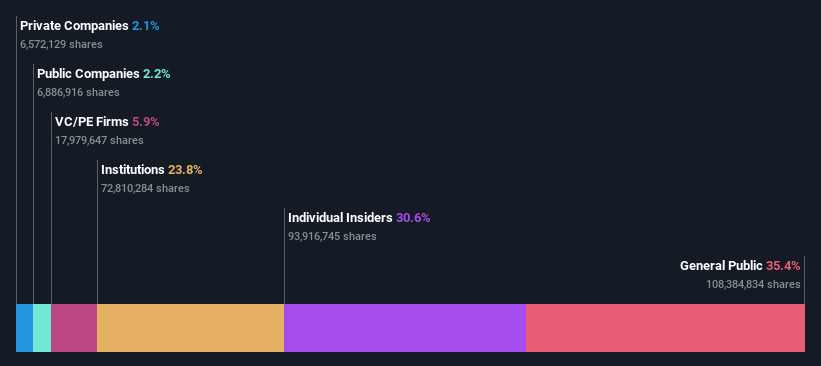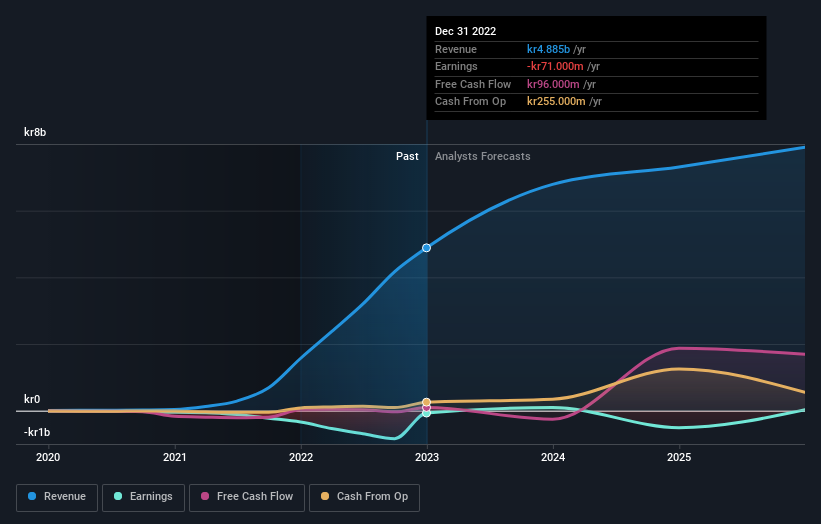- Sweden
- /
- Personal Products
- /
- OM:HUMBLE
Humble Group AB (publ)'s (STO:HUMBLE) 18% gain last week benefited both retail investors who own 35% as well as insiders

Key Insights
- Significant control over Humble Group by retail investors implies that the general public has more power to influence management and governance-related decisions
- 50% of the business is held by the top 11 shareholders
- Insiders have been buying lately
To get a sense of who is truly in control of Humble Group AB (publ) (STO:HUMBLE), it is important to understand the ownership structure of the business. With 35% stake, retail investors possess the maximum shares in the company. Put another way, the group faces the maximum upside potential (or downside risk).
While retail investors were the group that benefitted the most from last week’s kr351m market cap gain, insiders too had a 31% share in those profits.
In the chart below, we zoom in on the different ownership groups of Humble Group.
Check out our latest analysis for Humble Group

What Does The Institutional Ownership Tell Us About Humble Group?
Many institutions measure their performance against an index that approximates the local market. So they usually pay more attention to companies that are included in major indices.
Humble Group already has institutions on the share registry. Indeed, they own a respectable stake in the company. This suggests some credibility amongst professional investors. But we can't rely on that fact alone since institutions make bad investments sometimes, just like everyone does. It is not uncommon to see a big share price drop if two large institutional investors try to sell out of a stock at the same time. So it is worth checking the past earnings trajectory of Humble Group, (below). Of course, keep in mind that there are other factors to consider, too.

Hedge funds don't have many shares in Humble Group. Looking at our data, we can see that the largest shareholder is Håkan Roos with 10% of shares outstanding. For context, the second largest shareholder holds about 9.1% of the shares outstanding, followed by an ownership of 5.9% by the third-largest shareholder. Noel Abdayem, who is the second-largest shareholder, also happens to hold the title of Chief Operating Officer. Additionally, the company's CEO Simon Petren directly holds 2.0% of the total shares outstanding.
A closer look at our ownership figures suggests that the top 11 shareholders have a combined ownership of 50% implying that no single shareholder has a majority.
While studying institutional ownership for a company can add value to your research, it is also a good practice to research analyst recommendations to get a deeper understand of a stock's expected performance. There is some analyst coverage of the stock, but it could still become more well known, with time.
Insider Ownership Of Humble Group
The definition of company insiders can be subjective and does vary between jurisdictions. Our data reflects individual insiders, capturing board members at the very least. The company management answer to the board and the latter should represent the interests of shareholders. Notably, sometimes top-level managers are on the board themselves.
Most consider insider ownership a positive because it can indicate the board is well aligned with other shareholders. However, on some occasions too much power is concentrated within this group.
Our most recent data indicates that insiders own a reasonable proportion of Humble Group AB (publ). It has a market capitalization of just kr2.3b, and insiders have kr712m worth of shares in their own names. This may suggest that the founders still own a lot of shares. You can click here to see if they have been buying or selling.
General Public Ownership
With a 35% ownership, the general public, mostly comprising of individual investors, have some degree of sway over Humble Group. While this size of ownership may not be enough to sway a policy decision in their favour, they can still make a collective impact on company policies.
Private Equity Ownership
With an ownership of 5.9%, private equity firms are in a position to play a role in shaping corporate strategy with a focus on value creation. Some might like this, because private equity are sometimes activists who hold management accountable. But other times, private equity is selling out, having taking the company public.
Next Steps:
While it is well worth considering the different groups that own a company, there are other factors that are even more important. To that end, you should learn about the 2 warning signs we've spotted with Humble Group (including 1 which doesn't sit too well with us) .
If you are like me, you may want to think about whether this company will grow or shrink. Luckily, you can check this free report showing analyst forecasts for its future.
NB: Figures in this article are calculated using data from the last twelve months, which refer to the 12-month period ending on the last date of the month the financial statement is dated. This may not be consistent with full year annual report figures.
Valuation is complex, but we're here to simplify it.
Discover if Humble Group might be undervalued or overvalued with our detailed analysis, featuring fair value estimates, potential risks, dividends, insider trades, and its financial condition.
Access Free AnalysisHave feedback on this article? Concerned about the content? Get in touch with us directly. Alternatively, email editorial-team (at) simplywallst.com.
This article by Simply Wall St is general in nature. We provide commentary based on historical data and analyst forecasts only using an unbiased methodology and our articles are not intended to be financial advice. It does not constitute a recommendation to buy or sell any stock, and does not take account of your objectives, or your financial situation. We aim to bring you long-term focused analysis driven by fundamental data. Note that our analysis may not factor in the latest price-sensitive company announcements or qualitative material. Simply Wall St has no position in any stocks mentioned.
About OM:HUMBLE
Humble Group
Develops, refines, and distributes fast-moving consumer products in Sweden and internationally.
Good value with reasonable growth potential.
Market Insights
Community Narratives



